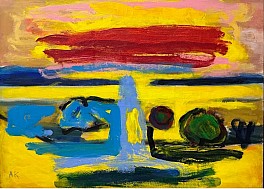BIOGRAPHY

American (1922-2022)
By the early 1950s, New York School avant-garde art was considered synonymous with Abstract Expressionism, but there were a group of "dissenters," many of whom had studied at the Hans Hofmann School of art, who refused to abandon the figure even as they incorporated the tenets of Abstract Expressionism into their art. Many of these artists gathered around the Jane Street Gallery, the first artists' cooperative, and included Paul Resika, Nell Blaine, Judith Rothschild, Jane Freilicher, Larry Rivers--and Albert Kresch. Kresch, who shared a studio of De Kooning for a time in the 40s, was known for his later landscapes, intimate in size, imbued with saturated color, and composed with layers upon layers of paint.
Born in Scranton, PA, Kresch moved with his family to New York in the 30’s. He began studying figure drawing at the Brooklyn Museum, but soon enrolled in the Hans Hoffman School. Among his peers were Leland Bell, Louisa Mattiasdottir, Nell Blaine, Judith Rothschild, Robert De Niro Sr. and Virginia Admiral.
In the 40’s he exhibited abstract work in his first two shows at the Jane Street Gallery at a time when Abstract Expressionism was gathering steam. He soon embarked however on an independent path inspired by the French artist, Jean Helion to return to representational painting. Kresch came to regard abstraction not as an end in itself, but as an armature to support representational form. The structure that abstraction gave him underlies the dynamism of his landscapes, which are striking for their highly saturated color and dry-brushed scumble at the edges of strongly contrasting hues.
A modest man--a character trait that differentiated him from many of the Abstract Expressionist painters of the day, "Albert Kresch i[was] a painter's painter, almost indecently reticent about showing his work over the years," as the critic Michael Kimmelman wrote.
